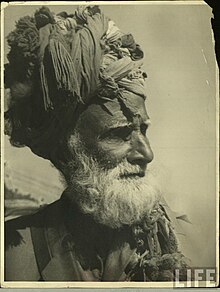Punjabis
ethnolinguistic group native to the Punjab
The Punjabi people (Punjabi: پنجابی, ਪੰਜਾਬੀ Panjabi people) are an Indo-Aryan ethnic group native to the Punjab region in northwestern South Asia (Pakistan and India). They come from the Panjab region, which has been home to some of the oldest civilizations in the world including one of the world's first and oldest civilizations, the Indus Valley Civilization. The Punjabi identity is usually cultural and linguistic, with Punjabis being those whose first language is Panjabi, an Indo-European language.
| |
|---|---|
 Potrait of a Punjabi man in the Pakistani Punjab | |
| Total population | |
| c. 310 million[1][2][3][4] | |
| Regions with significant populations | |
| 129,986,959 (2023)[a][6][7][8] | |
| 42,520,211 (2022)[b][3][c][10] | |
| 1,234,170 (2023)[11][d] | |
| 700,000 (2006)[12] | |
| 253,740[13] | |
| 132,496 (2017)[14] | |
| 64,000 | |
| 56,400 (2019)[15] | |
| 50,000 (2016)[16] | |
| 37,000 | |
| 34,227 (2018)[17] | |
| 26,000 | |
| 26,000 | |
| 24,000 (2013)[18] | |
| 23,700 (2019)[19] | |
| 18,000 (2020)[20] | |
| 10,000 (2019)[21] | |
| Languages | |
| Majority: Panjabi and its dialects | |
| Religion | |
| Pakistani Panjab: Indian Panjab: | |
| Related ethnic groups | |
| Other Indo-Aryan peoples | |
Notes
change- ↑ Punjabis comprise 61.8% (129,986,959) of Pakistan's total population of 232,923,845 per 2023 estimate by the World Factbook.[5]
- ↑ Punjabis comprise 3% (42,520,211) of India's total population of 1,389,637,446 per 2023 estimate by the World Factbook.[9]
- ↑ This figure comprises speakers of the Punjabi language in India. Ethnic Punjabis who no longer speak the language are not included in this number.
- ↑ Statistic includes all speakers of the Punjabi language.
References
change- ↑ "Punjabi - Worldwide distribution".
- ↑ Punjabis at Ethnologue (21st ed., 2018)
- ↑ 3.0 3.1 "Abstract Of Speakers' Strength Of Languages And Mother Tongues - 2011" (PDF). Registrar General and Census Commissioner of India. Archived from the original (PDF) on 20 February 2022. Retrieved 12 June 2022.
- ↑ "Pakistan Census 2017" (PDF). www.pbs.pk. Retrieved 20 September 2020.
- ↑ "South Asia :: Pakistan — The World Fact book - Central Intelligence Agency". www.cia.gov. Retrieved 20 September 2020.
- ↑ "Ethnic Groups in Pakistan". Worldatlas.com. 30 July 2019.
Punjabi people are the ethnic majority in the Punjab region of Pakistan and Northern India accounting for 44.7% of the population in Pakistan.
- ↑ "Pakistan Census 2017" (PDF). www.pbs.pk. Retrieved 20 September 2020.
- ↑ "Punjabi - Worldwide distribution".
- ↑ "South Asia :: India — The World Fact book - Central Intelligence Agency". www.cia.gov. Retrieved 8 May 2022.
- ↑ "Punjabi - Worldwide distribution".
- ↑ Government of Canada, Statistics Canada (17 August 2022). "Census Profile, 2021 Census of Population Profile table Canada [Country]". www12.statcan.gc.ca. Retrieved 18 August 2022.
- ↑ McDonnell, John (5 December 2006). "Punjabi Community". House of Commons. Retrieved 3 August 2016.
We now estimate the Punjabi community at about 700,000, with Punjabi established as the second language certainly in London and possibly within the United Kingdom.
- ↑ "US Census Bureau American Community Survey (2009-2013) See Row #62". 2.census.gov.
- ↑ "Top ten languages spoken at home in Australia". Archived from the original on 9 July 2017.
- ↑ "Malaysia". Ethnologue.com. Retrieved 28 July 2019.
- ↑ "Punjabi community involved in money lending in Philippines braces for 'crackdown' by new President". 18 May 2016.
- ↑ "New Zealand". Stats New Zealand. Retrieved 24 September 2019.
- ↑ Strazny, Philipp (1 February 2013). Encyclopedia of Linguistics. Routledge. ISBN 978-1-135-45522-4 – via Google Books.
- ↑ "Bangladesh". Ethnologue.com. Retrieved 28 July 2019.
- ↑ "Deutsche Informationszentrum für Sikhreligion, Sikhgeschichte, Kultur und Wissenschaft (DISR)". remid.de. Retrieved 3 January 2020.
- ↑ "National Population and Housing Census 2011" (PDF). Unstats.unorg. Retrieved 29 July 2019.
- ↑ "C-1 Population By Religious Community - 2011". Archived from the original (XLS) on 23 September 2015. Retrieved 29 July 2019.
- ↑ Wade Davis; K. David Harrison; Catherine Herbert Howell (2007). Book of Peoples of the World: A Guide to Cultures. National Geographic. pp. 132–133. ISBN 978-1-4262-0238-4.
- ↑ "Punjabis". Encyclopaedia.